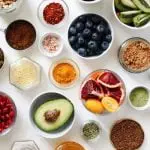
Image by Darren Muir / Stocksy
October 30, 2022
Our editors have independently chosen the products listed on this page. If you purchase something mentioned in this article, we may
Food is fuel since calories are literally a unit of energy. Yet it’s not a direct link between how much energy a food provides and how much energy you feel you can exert. What you eat makes a big difference in how far that energy will take you. Some bites can go the distance, while others fizzle out within a matter of minutes.
Here are the top foods that will give you sustained energy, and how to work them into your diet.
Advertisement
This ad is displayed using third party content and we do not control its accessibility features.
How food impacts energy.
“Overall energy is impacted by how well our mitochondria are functioning,” says Lindley Wells, CNS, LDN at Dr. Lana Wellness. “Mitochondria are the powerhouses of the cells and produce the energy that fuels us and makes everything in the body run. This means that eating foods that support optimal mitochondrial function can promote overall energy balance.”
The calories you eat are made up of macronutrients, adds Kimberly Gomer, RD, LDN, director of nutrition at Body Beautiful Miami. Macronutrients consist of carbohydrates, proteins, and fats. There are also micronutrients—the vitamins and minerals in these foods that are involved in how energy is used and processed.
“Many people feel sluggish after a high-fat, high-calorie meal,” says Gomer. “Those calories wind up being a drain on energy because they are being directed toward digestion.” That’s what makes it so important to be mindful of the components of what you’re eating, says Wells, and focus on fitting more energizing nutrients into your diet.
Advertisement
This ad is displayed using third party content and we do not control its accessibility features.
What to eat for an energy boost.
Here are six nutrients that will provide long-lasting energy, plus the foods that you’ll find them in and recipes to make meal planning a breeze.
Omega-3s
Found in:
Chia seeds, hemp seeds, flax seeds, sardines, salmon, anchovies, mackerel, herring, dark leafy greens, olives, olive oil, and avocado.
Advertisement
This ad is displayed using third party content and we do not control its accessibility features.
Energy benefits:
“These healthy sources of fats are critical for brain health, reduce inflammation, and are absorbed by cell membranes,” says Wells.
Research published in Oxidative Medicine and Cellular Longevity also states that there is a link between omega-3 intake and mood disorders1 which zap energy, like depression. Adequate omega-3 consumption helps maintain brain structures and preserve their function while preventing or decreasing inflammation in those who are dealing with depression.
How to eat it:
Chia pudding is a no-fuss morning meal to start your day with a scoop of omega-3s. Try these riff-able recipes.
Fatty fish is also a great source of omega-3 fats. If you’re not into salmon and the likes or forget to consistently stock up on seeds, a fish oil supplement is another route to making sure you’re getting enough omega-3s in your diet.
Be consistent with when you take your omega-3 supplement and pair it with a high-fat snack or meal, such as a few slices of cheese and crackers. Research published in Current Opinion in Clinical Nutrition and Metabolic Care found that this may improve the bioavailability of omega-3s found in fish oil supplements, making them more effective.
Advertisement
This ad is displayed using third party content and we do not control its accessibility features.
Selenium
Found in:
Brazil nuts, oysters, tuna, lobster, crab, salmon, cod, halibut, sardines, shrimp, turkey, eggs, and spinach.
Advertisement
This ad is displayed using third party content and we do not control its accessibility features.
Energy benefits:
“Selenium plays a critical role in supporting ATP production in the mitochondria,” says Wells. ATP is the main energy molecule used as power for all cellular processes. Further research published in BMC Neuroscience found that selenium preserves mitochondrial function2 and can even prevent hypoxic cell damage, an event that happens as a result of cardiac disease or hypotension.
How to eat it:
Riboflavin (Vitamin B2) & Thiamine (Vitamin B1)
Vitamin B2 found in:
Liver, beef, mushrooms, almonds, chicken, eggs, and quinoa.
Vitamin B1 found in:
Navy beans, black beans, split peas, lentils, sunflower seeds, barley, beef, and wild rice.
Energy benefits:
Like selenium, B vitamins help with ATP production and preserve mitochondrial function. They also help convert carbohydrates into glucose, which is then converted into energy.
Research published in Nutrients states that riboflavin also protects against lipid peroxides3. This can cause oxidative stress to lipids—naturally occurring molecules in the body that are responsible for storing energy.
Researchers also state that having balanced thiamine levels protects not only against cognitive fatigue, but also physical fatigue. In a separate study with 16 male athletes, thiamine supplementation decreased self-assessed fatigue after a cycling workout.
How to eat it:
Some bars or other packaged and processed foods may have B vitamins on the label. When possible, stick to whole foods. That’s because Gomer says processed foods can cause an insulin spike, raising blood sugar and plummeting energy levels with it. Luckily, vitamin B-rich beans are a perfect base for veggie burgers. Here are three simple veggie burger recipes to make this week.
Vitamin E
Found in:
Sunflower seeds, almonds, hazelnuts, pine nuts, peanuts, avocado, spinach, dandelion greens, crab, and Brazil nuts.
Energy benefits:
Vitamin E is an antioxidant, protecting cells from damage due to free radicals that may increase the risk of aging and certain diseases. As an antioxidant, however, vitamin E has an important role in increasing energy levels, too.
Research published in Clinical Biochemistry and Nutrition found that eating antioxidant-rich foods increased carbohydrate oxidation4, resulting in higher ATP production for energy and higher oxygen uptake for muscles during exercise. More oxygen circulating around the body during exercise means that more ATP is being used to create more energy. It’s a good idea to eat vitamin E-rich foods 30 minutes to an hour before exercising.
How to eat it:
Grab a handful of nuts or a slice of avocado toast for a quick vitamin E fix.
CoQ10
Found in:
Fatty fish like salmon, liver, and whole grains.
Energy benefits:
How to eat it:
It makes sense to pair foods with CoQ10 and vitamin E together, like these salmon cakes with avocado spread.
Again, whole food sources are key here to maintain steady blood sugar levels that won’t chip away at your energy bank. “When insulin is balanced by eating a whole foods diet, focusing on protein, vegetables, and carbohydrates, this provides the most reliable and stable energy because calories are provided for energy but there is no spike in insulin,” says Gomer.
Worst foods for energy.
“Some foods contain artificial energy,” says Gomer. “These foods cause energy to go up but ultimately lead to lower energy levels and even affect sleep.”
Wells says the most common energy-sabotaging foods that may provide an initial boost only to follow with a slump include:
- Beverages with caffeine, such as coffee, soda, and energy drinks.
- Processed, packaged chips, crackers, and cookies.
- Fruit juices and dried fruit.
- Fruits higher in fructose like apples, grapes, and watermelon
- Foods high in trans-fat like frozen foods, fried foods, and baked goods.
“If you are craving something sweet it’s best to eat it after a meal or paired with protein and/or fat so as to not have a large spike in blood sugar,” adds Wells.
And while having your beloved morning coffee isn’t doing you any favors when it comes to energy, you may simply need to dial your intake back. “In the long-term caffeine depletes adenosine in our mitochondria,” says Wells. “Adenosine is a critical component of ATP—the body’s source of energy. If you find yourself having a lot of energy right after a caffeinated beverage but have low energy or a crash hours later, it may be worth significantly reducing how much you’re drinking.”
How to maintain energy throughout the day.
Your diet is just one part of the energy equation. Here are some other hacks to help:
- Manage stress: “Cortisol is the stress hormone that when over-secreted can cause energy dips,” says Gomer. “Get in regular daily exercise, practice meditation, and focus on daily breath work to help stabilize your mood and energy simultaneously.”
- Get quality sleep: Gomer says an easy way to know if you’re getting enough sleep is if you can wake up without an alarm and feel rested. Here’s how to improve your sleep on a nightly basis.
- Rise and shine (in your eyes): “Getting sunlight on your eyes within the first 15 minutes of waking up helps with cortisol and melatonin regulation and your body’s circadian rhythm,” says Wells.
- Reduce your toxic burden: Try not to make yourself crazy (or increase those stress levels) but Wells suggests that thinking twice about what you store your food in, cook with, and use on a daily basis may improve energy levels.
- Stay hydrated: Being dehydrated means your body has to work harder, plucking from your energy reserves. Dehydration can also be masked as fatigue. Plus, water has loads of other health benefits you’ll want in addition to more energy.
The takeaway.
When it comes to eating for energy, every body is different. That means that some people may respond positively to certain nutrients, or even eating those nutrients at certain times of the day, than others.
If you already regularly incorporate the above foods into your diet and are looking for other ways to increase your energy levels, stock up on these superfoods. And once you’ve taken stock of how food impacts your personal energy levels, look into metabolic conditioning as a next step to help your body use its energy more efficiently.









